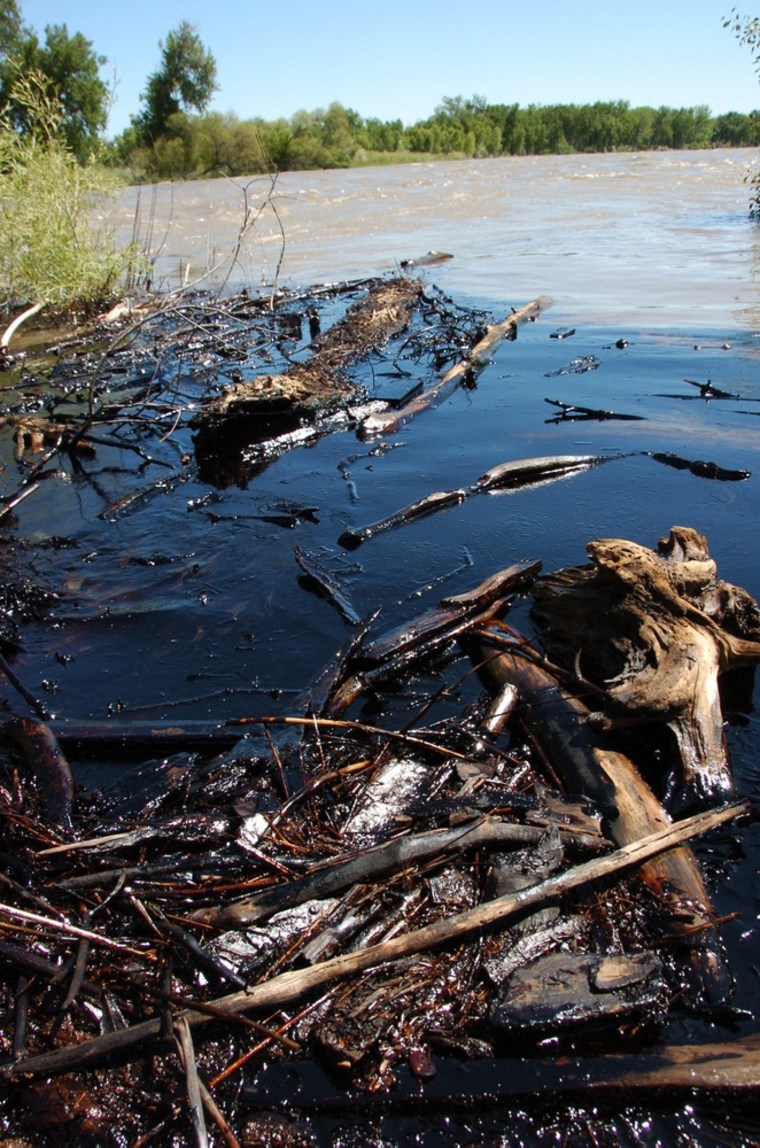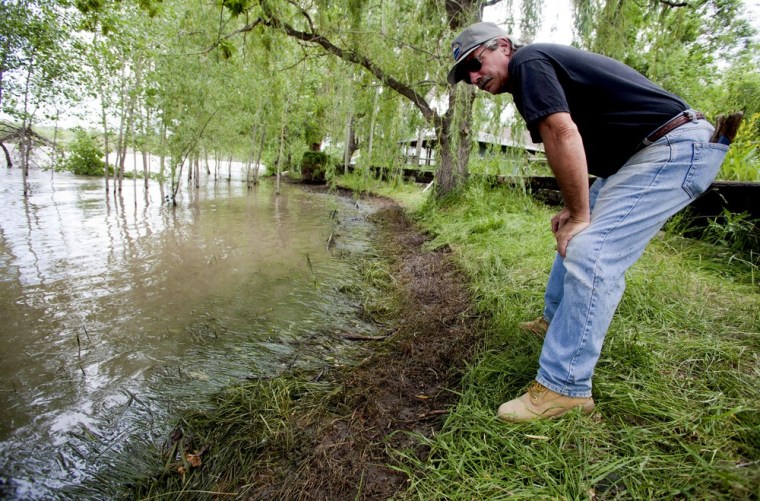By size it's no BP or Exxon Valdez spill, each of which dumped millions of gallons of oil, but the 42,000-gallon spill in the Yellowstone River still worries locals, state officials and environmentalists over potential long-term effects on property and wildlife.
For one, while the amount spilled is tiny compared to the other disasters, the most heavily impacted area is also compact — a relatively narrow, 30-mile stretch along the longest undammed river in the U.S.
And while Yellowstone National Park is not threatened because it's upriver by about 110 miles, the stretch polluted by the severed Exxon Mobil pipeline is a fly fishing and birdwatching haven.
Key to the situation is that the river is at flood stage. Fast water doesn't allow the oil to settle in the middle of the river and instead pushes it through faster, which is a good thing.
The river's flowing at more than 30,000 cubic feet per second, Bob Gibson, spokesman for the Montana Fish, Wildlife & Parks Commission, told msnbc.com. That's about 220,000 gallons a second.
But that also creates a problem: Oil pools in some shallow areas and settles in others on flooded riverbanks and property as the river recedes, leaving what Gibson calls "bathtub rings" around trees.
"The high water is both a blessing and a curse," he said.
No oiled birds or dead fish have been found, but the bigger question is whether the spill will have a long-term impact.
Montana Audubon — a nonprofit that specializes in wildlife conservation, especially birds — fears for the health of the American white pelican, a top-of-the-food chain species that dines on critters in the river.
"We may get lucky with the short-term effects" because birds weren't using their normal river habitat due to the high water, said Darcie Vallant, director of the Audubon Conservation Education Center in Billings, which is just 10 miles from the spill.
"But the concern is long-term effects," especially with the pelicans, she added.
Montana had some 7,000 breeding pairs in 2010, and that was a decline from the previous year, she said.

The high water has also made it impossible to assess what's happening to that ecosystem.
"There's a lot of stuff that lives below the surface that we can't see yet," said Gibson.
"We can't get to a large piece of the river due to the flooding," he added. It will probably take several weeks just to get a jet boat on the river because cottonwood trees and other floating debris make it too dangerous for now, he said.
Gibson doesn't expect to see dead fish floating along the river, and he doubts fishing will be put on hold. But he does worry about the oil reducing the numbers of "all the little things that fish eat."
Fish species there include sauger, bass, catfish, goldeye, trout and, farther downstream, native pallid sturgeon.
Bruce Farling, head of Trout Unlimited's Montana chapter, fears surging floodwater could push into back channels full of fish eggs and recently hatched fish.
"If we get a bunch of oil in some of these backwater areas, these are precisely where these small fish rear," he said.
Montana State University researchers will be among those monitoring the river, but it could take months before they have a sense of the recovery's pace.
"In the weeks and months ahead, we will be looking for any unusual changes in the river's natural environment and any impacts on the species of fish we would expect to find at this time of year," said MSU ecology professor Al Zale. "Some species or ages of fish may be more susceptible to this type of pollution than others."
As for property owners, Yellowstone County Commissioner John Ostlund told the Billings Gazette that "every landowner along the river from Laurel to Coulson will have some issues."
"Between Billings and Laurel, any place there's backwater, that oil floats on the top, so it's migrating to the sides and it's stuck on any land where the water level is dropping," he added.
Cathy Williams, who raises livestock, wheat, alfalfa and hay with her husband near Laurel, said high water washed oil across much of their 800 acres.
"It was the night the river peaked, so the river water was flooded all over the place, and that brought oil all over both ranches," she said. "All of our grasslands ... have just thick, black crude stuck to all the grass, trees, low lands."
Williams said their spring wheat crop and alfalfa are both in need of irrigation, but farmers in the area were advised not to take water from the river for the time being. Drinking supplies also are in limbo, she said.
"We get all our drinking water from our wells and for our animals," Williams said. "All the groundwater, I assume, is probably contaminated. We just don't know."
